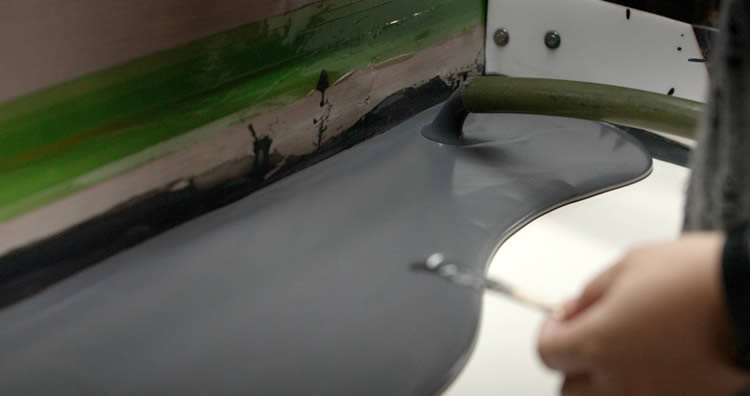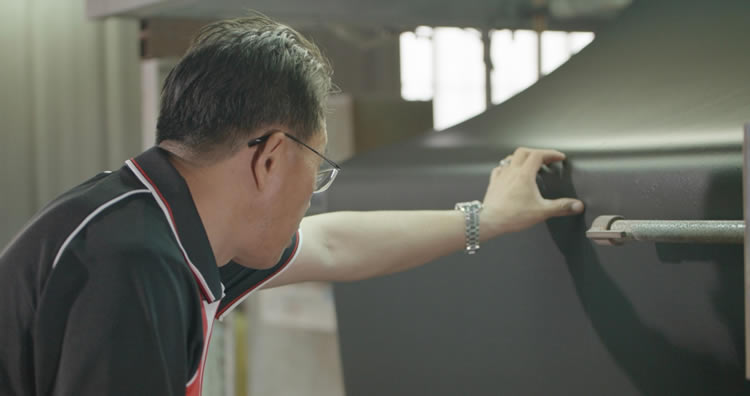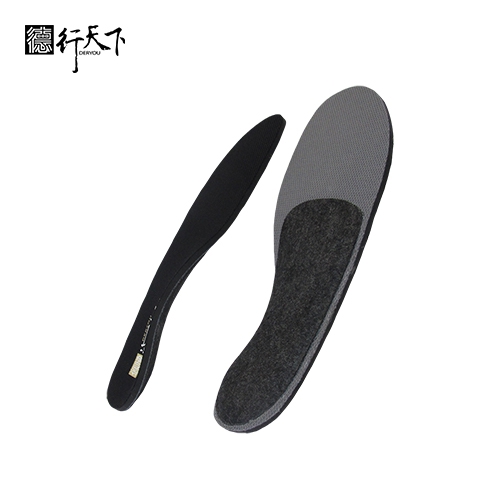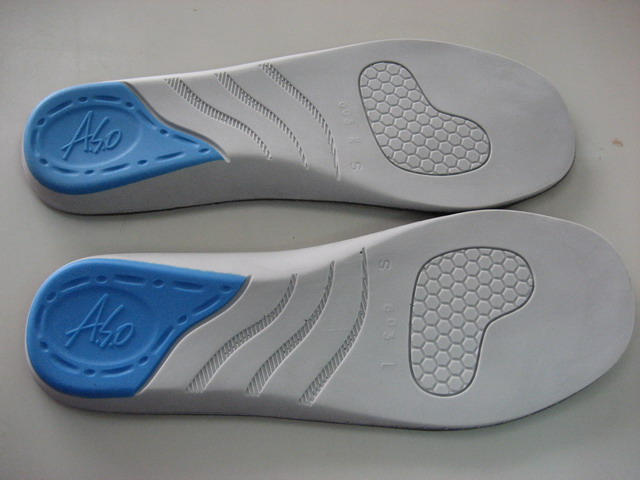
GuangXin Industrial Co., Ltd. is a specialized manufacturer dedicated to the development and production of high-quality insoles.
With a strong foundation in material science and footwear ergonomics, we serve as a trusted partner for global brands seeking reliable insole solutions that combine comfort, functionality, and design.
With years of experience in insole production and OEM/ODM services, GuangXin has successfully supported a wide range of clients across various industries—including sportswear, health & wellness, orthopedic care, and daily footwear.
From initial prototyping to mass production, we provide comprehensive support tailored to each client’s market and application needs.
At GuangXin, we are committed to quality, innovation, and sustainable development. Every insole we produce reflects our dedication to precision craftsmanship, forward-thinking design, and ESG-driven practices.
By integrating eco-friendly materials, clean production processes, and responsible sourcing, we help our partners meet both market demand and environmental goals.


At GuangXin Industrial, our core strength lies in our deep expertise and versatility in insole and pillow manufacturing. We specialize in working with a wide range of materials, including PU (polyurethane), natural latex, and advanced graphene composites, to develop insoles and pillows that meet diverse performance, comfort, and health-support needs.
Whether it's cushioning, support, breathability, or antibacterial function, we tailor material selection to the exact requirements of each project-whether for foot wellness or ergonomic sleep products.
We provide end-to-end manufacturing capabilities under one roof—covering every stage from material sourcing and foaming, to precision molding, lamination, cutting, sewing, and strict quality control. This full-process control not only ensures product consistency and durability, but also allows for faster lead times and better customization flexibility.
With our flexible production capacity, we accommodate both small batch custom orders and high-volume mass production with equal efficiency. Whether you're a startup launching your first insole or pillow line, or a global brand scaling up to meet market demand, GuangXin is equipped to deliver reliable OEM/ODM solutions that grow with your business.



GuangXin offers exceptional flexibility in customization and OEM/ODM services, empowering our partners to create insole products that truly align with their brand identity and target market. We develop insoles tailored to specific foot shapes, end-user needs, and regional market preferences, ensuring optimal fit and functionality.
Our team supports comprehensive branding solutions, including logo printing, custom packaging, and product integration support for marketing campaigns. Whether you're launching a new product line or upgrading an existing one, we help your vision come to life with attention to detail and consistent brand presentation.
With fast prototyping services and efficient lead times, GuangXin helps reduce your time-to-market and respond quickly to evolving trends or seasonal demands. From concept to final production, we offer agile support that keeps you ahead of the competition.
Quality is at the heart of everything we do. GuangXin implements a rigorous quality control system at every stage of production—ensuring that each insole meets the highest standards of consistency, comfort, and durability.
We provide a variety of in-house and third-party testing options, including antibacterial performance, odor control, durability testing, and eco-safety verification, to meet the specific needs of our clients and markets.
Our products are fully compliant with international safety and environmental standards, such as REACH, RoHS, and other applicable export regulations. This ensures seamless entry into global markets while supporting your ESG and product safety commitments.
At GuangXin Industrial, we are committed to integrating ESG (Environmental, Social, and Governance) values into every step of our manufacturing process. We actively pursue eco-conscious practices by utilizing eco-friendly materials and adopting low-carbon production methods to reduce environmental impact.
To support circular economy goals, we offer recycled and upcycled material options, including innovative applications such as recycled glass and repurposed LCD panel glass. These materials are processed using advanced techniques to retain performance while reducing waste—contributing to a more sustainable supply chain.
We also work closely with our partners to support their ESG compliance and sustainability reporting needs, providing documentation, traceability, and material data upon request. Whether you're aiming to meet corporate sustainability targets or align with global green regulations, GuangXin is your trusted manufacturing ally in building a better, greener future.
Looking for a reliable insole manufacturing partner that understands customization, quality, and flexibility? GuangXin Industrial Co., Ltd. specializes in high-performance insole production, offering tailored solutions for brands across the globe. Whether you're launching a new insole collection or expanding your existing product line, we provide OEM/ODM services built around your unique design and performance goals.
From small-batch custom orders to full-scale mass production, our flexible insole manufacturing capabilities adapt to your business needs. With expertise in PU, latex, and graphene insole materials, we turn ideas into functional, comfortable, and market-ready insoles that deliver value.
Contact us today to discuss your next insole project. Let GuangXin help you create custom insoles that stand out, perform better, and reflect your brand’s commitment to comfort, quality, and sustainability.
🔗 Learn more or get in touch:
🌐 Website: https://www.deryou-tw.com/
📧 Email: shela.a9119@msa.hinet.net
📘 Facebook: facebook.com/deryou.tw
📷 Instagram: instagram.com/deryou.tw
Cushion insole OEM solution Taiwan
Are you looking for a trusted and experienced manufacturing partner that can bring your comfort-focused product ideas to life? GuangXin Industrial Co., Ltd. is your ideal OEM/ODM supplier, specializing in insole production, pillow manufacturing, and advanced graphene product design.
With decades of experience in insole OEM/ODM, we provide full-service manufacturing—from PU and latex to cutting-edge graphene-infused insoles—customized to meet your performance, support, and breathability requirements. Our production process is vertically integrated, covering everything from material sourcing and foaming to molding, cutting, and strict quality control.Thailand eco-friendly graphene material processing
Beyond insoles, GuangXin also offers pillow OEM/ODM services with a focus on ergonomic comfort and functional innovation. Whether you need memory foam, latex, or smart material integration for neck and sleep support, we deliver tailor-made solutions that reflect your brand’s values.
We are especially proud to lead the way in ESG-driven insole development. Through the use of recycled materials—such as repurposed LCD glass—and low-carbon production processes, we help our partners meet sustainability goals without compromising product quality. Our ESG insole solutions are designed not only for comfort but also for compliance with global environmental standards.Custom foam pillow OEM in Vietnam
At GuangXin, we don’t just manufacture products—we create long-term value for your brand. Whether you're developing your first product line or scaling up globally, our flexible production capabilities and collaborative approach will help you go further, faster.Customized sports insole ODM Vietnam
📩 Contact us today to learn how our insole OEM, pillow ODM, and graphene product design services can elevate your product offering—while aligning with the sustainability expectations of modern consumers.Custom foam pillow OEM in Thailand
A groundbreaking study by UC San Diego researchers has uncovered thousands of new bile acids, shedding light on their critical roles beyond digestion and highlighting their potential in treating various diseases. This discovery marks a significant step forward in our understanding of the gut microbiome’s communication with the body and human metabolism. Scientists at the Skaggs School of Pharmacy and Pharmaceutical Sciences, part of the University of California San Diego, have discovered thousands of new bile acids. These molecules are used by our gut microbiome to communicate with the rest of the body. “Bile acids are a key component of the language of the gut microbiome, and finding this many new types radically expands our vocabulary for understanding what our gut microbes do and how they do it,” said senior author Pieter Dorrestein, Ph.D., professor at Skaggs School of Pharmacy and Pharmaceutical Sciences and professor of pharmacology and pediatrics at UC San Diego School of Medicine. “It’s like going from ‘See Spot Run’ to Shakespeare.” Unraveling Microbial Languages The results, as described by study co-author and bile acids expert Lee Hagey, Ph.D., are akin to a molecular Rosetta stone, providing previously unknown insight into the biochemical language microbes use to influence distant organ systems. Bile acids originate in the liver, are stored in the gallbladder and ultimately released into the intestine, where they are deployed to aid in digestion following the consumption of a meal. The microbes in our gut metabolize the bile acids produced by the liver, changing them into a vast array of different molecules called secondary bile acids, which tend to be easier for the body to absorb. Until now, the rich diversity and range of functions of secondary bile acids have been underappreciated by scientists. This research was completed by members of the Dorrestein lab (from left to right: Helena Mannochio-Russo, Ipsita Mohanty, Lee Hagey, and Pieter Dorrestein). Credit: UC San Diego Health Sciences “When I started working in the lab, there were about a few hundred known bile acids,” said study co-author Ipsita Mohanty, Ph.D., a postdoctoral researcher in the Dorrestein lab. “Now we’ve discovered thousands more, and we’re also working toward realizing that these bile acids do so much more than just help with digestion.” In addition to aiding digestion, bile acids are also important signaling molecules that help regulate the immune system and serve important metabolic functions, such as controlling lipid and glucose metabolism. These molecules also help explain how microbes in the gut are able to influence distant organ systems. “Because of their interaction with our microbiome, the influence of bile acids spreads far beyond the digestive system, and so could the diseases we treat with them – the list of diseases related to bile acids is a mile long, and there are several FDA approvals for these kinds of acids as treatments,” said co-author Helena Mannochio-Russo, Ph.D., also a postdoctoral researcher in the Dorrestein lab. Helena Mannochio-Russo, shown in this image, and Ipsita Mohanty collaborated to conduct mass spectrometry experiments that led to the identification of thousands of new bile acids, a type of molecule used by microbes to communicate. Credit: UC San Diego Health Sciences Collaborative Efforts and Future Directions In order to discover these molecules, the researchers leveraged the unique resources of UC San Diego. Dorrestein is director of the Collaborative Microbial Metabolite Center (CMMC), a first-of-its-kind collaboration between UC San Diego and UC Riverside that seeks to gather and centralize information about the metabolites that microbes produce to help researchers learn more about their impact on human health and the environment. “In other areas of biology like genomics, sharing data is common, but there hasn’t been an infrastructure in place for microbial metabolomics researchers to share data until now,” said Dorrestein “Ultimately these breakthroughs are the result of a convergence of collaboration and computing power, and we expect many more breakthroughs to come out of the CMMC.” Earlier this year, the team debuted a new tool that can instantly match microbes to the metabolites they produce. The present study is the first of potentially many studies to utilize the tool for specific types of molecules. The researchers next hope to explore the specific functions of their newly discovered bile acids as well as use their approach on other types of biomolecules, such as lipids or other kinds of acids. “We’re rewriting the textbook of human metabolism,” said Dorrestein. “If you’d have spoken to me a few years ago, I would have said we were decades away from solving this puzzle, but now, it could happen within five years. It’s really a remarkable change in our capabilities, and we believe it’s going to revolutionize the way we approach disease.” Reference: “The underappreciated diversity of bile acid modifications” by Ipsita Mohanty, Helena Mannochio-Russo, Joshua V. Schweer, Yasin El Abiead, Wout Bittremieux, Shipei Xing, Robin Schmid, Simone Zuffa, Felipe Vasquez, Valentina B. Muti, Jasmine Zemlin, Omar E. Tovar-Herrera, Sarah Moraïs, Dhimant Desai, Shantu Amin, Imhoi Koo, Christoph W. Turck, Itzhak Mizrahi, Penny M. Kris-Etherton, Kristina S. Petersen, Jennifer A. Fleming, Tao Huan, Andrew D. Patterson, Dionicio Siegel, Lee R. Hagey, Mingxun Wang, Allegra T. Aron and Pieter C. Dorrestein, 11 March 2024, Cell. DOI: 10.1016/j.cell.2024.02.019 This study was funded, in part, by the National Institutes of Health (grants U24DK133658, R01GM107550, U19AG063744, U01DK119702, S10OD021750), the Biotechnology and Biological Sciences Research Council and National Science Foundation (grant BBSRC/NSF 2152526), the Gordon & Betty Moore Foundation, Natural Sciences and Engineering Research Council of Canada (grant RGPIN-2020-04895).
Using pieces of a gallstone from a mummy from the 1500s, researchers have been able to reconstruct the E. coli genome. Credit: Division of Paleopathology of the University of Pisa Researchers used fragments taken from an Italian mummy to recreate the genome of a centuries-old strain of E. coli. Using fragments taken from a 16th-century mummy’s gallstone, a multinational team headed by scientists from McMaster University and the University of Paris Cité has identified and reconstructed the first ancient E. coli genome. George Long is a co-lead author of the study and a graduate student of bioinformatics in the Department of Anthropology. Credit: McMaster University The finding was recently published in the journal Communications Biology. A Hidden Opportunistic Pathogen Despite being a major cause of death and morbidity and significant public health concerns, E. coli does not cause pandemics. It is referred to as a commensal, a kind of bacterium that lives inside of us and may infect its host when conditions are right, such as during times of stress, underlying illness, or immunodeficiency. According to experts, many details of its evolutionary history, such as when it acquired new genes and antibiotic resistance, are still unknown. There are no historical records of deaths brought on by commensals like E. coli, in contrast to well-known pandemics like the Black Death, which persisted for centuries and killed as many as 200 million people worldwide. However, its impact on human health and mortality was likely enormous. “A strict focus on pandemic-causing pathogens as the sole narrative of mass mortality in our past misses the large burden that stems from opportunistic commensals driven by the stress of lives lived,” says evolutionary geneticist Hendrik Poinar, who is director of McMaster’s Ancient DNA Centre and a principal investigator at the university’s Michael G. DeGroote Institute for Infectious Disease Research. Healthy humans and animals often have modern E. coli in their intestines. While the majority of types are benign, a few of them may cause severe, even deadly food poisoning outbreaks and bloodstream infections. The resilient and adaptable bacterium is known to be particularly resistant to treatment. The 400-Year-Old Ancestor of E. coli Researchers now have a benchmark for comparing how the genome of the present bacteria has changed and adapted over the last 400 years thanks to the discovery of a 400-year-old ancestor. The well-preserved corpses of a group of Italian nobility whose mummified remains were utilized in the new study were found at the Abbey of Saint Domenico Maggiore near Naples in 1983. For the study, the researchers conducted a detailed analysis of one of the individuals, Giovani d’Avalos. A Neapolitan noble from the Renaissance period, he was 48 when he died in 1586, and thought to have suffered from chronic inflammation of the gallbladder due to gallstones. “When we were examining these remains, there was no evidence to say this man had E. coli. Unlike an infection like smallpox, there are no physiological indicators. No one knew what it was,” explains the lead author of the study, George Long, a graduate student of bioinformatics at McMaster who conducted the analysis with co-lead author Jennifer Klunk, a former graduate student in the university’s Department of Anthropology. Isolating Ancient E. coli Fragments The technological feat is particularly remarkable because E. coli is both complex and ubiquitous, living not only in the soil but also in our own microbiomes. Researchers had to meticulously isolate fragments of the target bacterium, which had been degraded by environmental contamination from many sources. They used the recovered material to reconstruct the genome. “It was so stirring to be able to type this ancient E. coli and find that while unique it fell within a phylogenetic lineage characteristic of human commensals that are today still causing gallstones,” says Erick Denamur, the leader of the French team that was involved in the strain characterization. “We were able to identify what was an opportunistic pathogen, dig down to the functions of the genome, and to provide guidelines to aid researchers who may be exploring other, hidden pathogens,” says Long. Reference: “A 16th century Escherichia coli draft genome associated with an opportunistic bile infection” by George S. Long, Jennifer Klunk, Ana T. Duggan, Madeline Tapson, Valentina Giuffra, Lavinia Gazzè, Antonio Fornaciari, Sebastian Duchene, Gino Fornaciari, Olivier Clermont, Erick Denamur, G. Brian Golding, and Hendrik Poinar, 16 June 2022, Communications Biology. DOI: 10.1038/s42003-022-03527-1 The study was funded by the Canadian Institute of Advanced Research.
Human-driven habitat changes in Southeast Asia are causing wild pig and macaque population booms, threatening ecosystems and increasing disease risks. Above is a pig-tailed macaque baby in Malaysia. Credit: Ecological Cascades Lab Rising Populations of Wild Pigs and Macaques Threaten Southeast Asia’s Forests Rising numbers of wild pigs and macaque monkeys in Southeast Asia pose risks to native forests and could lead to disease spread among livestock and humans, reveals a study led by The University of Queensland. Dr. Matthew Luskin, affiliated with UQ’s School of the Environment, alongside his team, gathered and assessed species population data from various parts of the region, some of it collected with a network of cameras. “Macaques and wild pigs are taking over Southeast Asia’s disturbed forests,” Dr Luskin said. “Humans are largely to blame for this by altering forests with logging and establishing palm oil farms which provide food and ideal breeding conditions for these animals. We saw that wild boar and macaque numbers were 400 percent higher in forests near the plantations than in untouched environments. These animals take full advantage of the farmland, raiding crops and thriving on calorie‐rich foods.” Setting and monitoring the camera traps provided Dr. Luskin with an up-close experience of the exploding numbers. “I encountered huge troops of macaques in Thailand, Malaysia, and Indonesia – they were everywhere in the forest edges, following us and interfering with our equipment,” Dr Luskin said. “At first it was frustrating but then was eerie as we became completely surrounded.” The Public Health Risks of Booming Mammal Populations Dr Luskin said there were significant human health risks in the rising pig and macaque populations. “The wildlife origins of the COVID-19 pandemic show that mammals in human-modified ecosystems often host high pathogen loads and pose serious zoonotic disease risks,” he said. “Both pigs and macaques are recognized as carriers of diseases that can be transmitted to people and they’re the most common species in a region considered to be the global zoonotic disease hotspot.” Collaborator, Professor Carlos Peres from the University of East Anglia (UK), said abnormally high populations of wildlife species that are disease reservoirs often occur in human-modified tropical forests. “This study again shows that densely settled rural areas in Southeast Asia may be a source of future human epidemics,” he said. Environmental Consequences of Unchecked Populations University of East Anglia and Southern University of Science and Technology (China) PhD candidate, Jonathan Moore, said the immediate effects of the population explosions could be seen on native flora in the affected regions. “Both pigs and macaques trigger negative cascading impacts in these pristine ecosystems,” Mr Moore said. “They kill the seeds and seedlings of native plants and eat bird and reptile eggs. The Malaysian pigs alone were found to reduce rainforest tree regeneration by 62 percent.” The researchers say action is needed to minimize population expansions of wild pigs and macaques. “Efforts to manage the populations of these species have failed in the past because of their rapid reproductive capacity and public outcry,” Dr Luskin said. “Nobody favors needless killing of wildlife but the negative social and ecological impacts from hyperabundant pest species do demand ethical and urgent management solutions.” Reference: “The rise of hyperabundant native generalists threatens both humans and nature” by Jonathan H. Moore, Luke Gibson, Zachary Amir, Wirong Chanthorn, Abdul Hamid Ahmad, Patrick A. Jansen, Calebe P. Mendes, Manabu Onuma, Carlos A. Peres and Matthew Scott Luskin, 13 June 2023, Biological Reviews. DOI: 10.1111/brv.12985
DVDV1551RTWW78V
Taiwan foot care insole ODM development factory 》where form meets function, every step of the wayCushion insole OEM solution Vietnam 》where every detail is tailored to your brandis identityThailand graphene sports insole ODM 》committed to ESG, comfort, and your brand is success